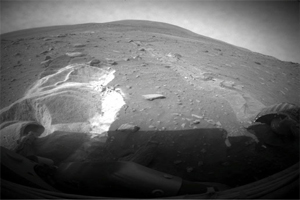 NASA's rover Spirit has churned up sulfate minerals in the
NASA's rover Spirit has churned up sulfate minerals in the
attempt to free itself from loose soil.
(Credit: NASA/JPL/Cornell)Some robots are born to greatness, and some have greatness forced upon them by circumstance. NASA's Mars rover Spirit has recently fallen into the latter category by making an accidental discovery in the course of trying to free itself from a sand trap….
Has it been six years since the twin rovers, Spirit and Opportunity, landed on Mars to begin their careers? Just about—next month is their landing anniversary.
Both rovers have shown signs of wear and tear, but Spirit, in its exploration range in Gusev Crater, has had the harder knocks. In fact, Spirit has driven backward for a couple of years now, due to a wheel that stopped working and which it was forced to drag through the Martian soil—a robot's form of limping.
About six months ago, Spirit became bogged down in loose soil, spinning its wheels but unable to break free of the trap—not unlike what happened to my car in Death Valley one time…and Spirit can't call upon the assistance of a National Park Ranger with an SUV and winch to help….
Over the months of entrapment, Spirit's handlers on Earth have continued to make measurements with the rover's instruments while trying to free it from its soil trap by manipulating its wheels in different ways (probably not unlike some of the strategies I tried to get my car out of the sand). But to no avail (either for Spirit or my car). Alas, is Spirit destined to remain a stationary explorer until its lifetime finally comes to an end?
